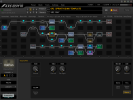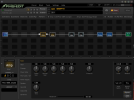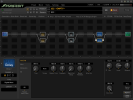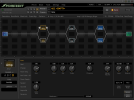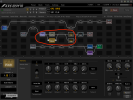Holy crap, that is a deep preset, would you mind sharing it, I'd like to study it when I have time.
I was able to build that preset with the FM9T using the default settings. Haven't played through it yet, but i'm at 84.8% cpu, no cpu message as of yet.
Here's the full preset with the loops and controllers in if you are interested in those things - I swapped in some random stock cabs as I use 3rd party (so it might sound a bit weird but that's not your interest anyway so ...), Just my take - lots of ways to skin a cat, I'm sure better ways also as I'm just a tinkering basement player so take what you will from it to help make your own processes. I only have a couple dozen patches all following variations of this template but with different core sounds suiting different guitars / styles / output modes (FR, Trad Cabs)
Careful loading this patch if you already have external controllers set up since this patch has all my controllers linked in (turn your external amps down - just in case).
NOTES:
Loops: (loops are controlled via channel switching on the associated Mixer blocks - my ocd likes that they all look the same in the grid)
- Loop4 - used for beginning of chain external fx. The Mixer4 block controls: ChA: Left side of loop opened slightly via expression pedal to add in a little Digitech Freqout pedal to the main path for feedback. ChB: Full signal redirected to right side of loop4 opened for Digitech Mosaic 12 String sim pedal (turns 6string into 12 string ... kind of)
- Loop3 - used to bring in an external switcher loaded with various external drive pedals + preamps etc pre-distortion (Left Side only of loop3 - Mixer3 ChB), and a TC Mimic Stereo doubler effect (alternative to using Enhancer block) on Mixer3 ChC). Mixer3 ChA is loop3 off/out of path.
- Loop2 - Used to bring in external post fx (Eventide H9 for mods + Source Aud Nemesis Delay - Mixer ChB - the mixer also compensates Loop2 to unity and straightens out a slight L/R balance issue I seem to have with Loop2). Mixer2 ChA is loop2 off/out of path.
External Controller Sources:
- Amp related - Gain - Expression pedal tied to Controller # 3 on Rhythm ChB only to dial back gain with compensating volume.
- Amp related - Bright - Switch tied to Controller # 8 to add brightness on Clean channel A only via increase on treble knob (or other depending on patch).
- Amp related - Boost - Switch tied to Controller # 4 to activate the amp blocks' pre boost feature (amp operations always occur on both amps when I use 2 amp blocks).
- Volume Related - Switch tied to Controller # 6 to raise post amp volume (patch volume) by 3db - set on the Return2 block's Output level control.
- Volume Related - Expression Pedal tied to Pedal # 2 for volume swells - set on the Return2 block's Return Level control.
- Delay Related - Expression Pedal tied to Controller # 5 for delay level - set on the delay block's input level control.
- Mod Related - Expression Pedal tied to Controller # 9 typically for mods rates - ie: set on the Rotarys' rate knobs for fast/slow.
- Wah Related - Expression Pedal tied to Controller # 1 for Wah control (auto activated).
- Pitch1 Related - Midi switch controls channel to select type ( ChA is dive bomb, ChB is Whammy Up, ChC is Capo, and ChD is Octave Divider.) - Expression Pedal tied to Controller # 2 Auto Activates for all channels and controls pitch on Divebomb/WhammyUp.
- Harmony - I use my Akai Midi Keyboard to change keys for Pitch2 diatonic (or, since we have no modifier for scale/mode, some code to figure out a matching major scale key to go with another mode/key that I want - would be great to have the scale parm modifiable).
Positioning
- Vibe and Driv1 blocks are placed in line with Input1 to pick up the impedance changes when selecting classic vibe, pi-fuzz and some others.
- Vol2 keeps my left side tone unaltered thru isolated Amp block (left) with single generated harmony added on the right side thru its own isolated Amp block (right) as mentioned above.
- Reverb in parallel so as not have reverb on the generated delays which is what I like today - tomorrow I may go back to in-series - frequent flipfloppery on this.
- Loop2 is placed between mods and delay because I may want, without changing fx order, to use just H9 to replace mods only, or just Source Audio Nemesis to replace Delays only, or, both to replace mods and delays externally.
- Pre flanger/chorus/rotary are stereo, so, without Drive1 on I will have their stereo signal retained throughout the chain. Turning drive1 on will collapse these pre mods to mono but no worries as I like the additional garbling sound that takes place when multiple signals pass thru distortion. I have some patches that have separate hard panned left / right drive blocks to retain the stereo signal, but I run out of CPU so have to use my outboard fx to allow for it (I need a turbo!). Even with separate panned L/R drives used though, putting stereo mod fx pre distortion still generates some of that garbled tone given there often being multiple signals present on both sides in mod fx. I've come to really like my mods pre distortion - more so than the more traditional post position (In a lot of my fav guitar sounds (ie. early Rush) I seem to hear mod content before distortion with that cool garbling sound), but I keep both available and switchable.
- I never use more than one mod at a time - so of the 12 present (pre Trem, Phaser, Vibe, Flanger, Chorus, Rotary, Detune, Harmony (I categorize Harmony as a mod), and Post Trem, Flanger, Chorus Rotary, only 1 is ever active at a time.
Channels
- Mostly, my blocks change channels with scenes to keep things simple ie: In scene1 fx blocks are set to A to suit the scene1 sound, In scene2 blocks are set to B to suit the scene2 sound... - I only use scenes 1-4. This includes Amps' channels (yes there is sometimes a switching gap but I don't gig so don't care much - if I did gig I wouldn't likely use such presets - prob mostly just mono).
- For a few blocks I don't follow the above channel standard. ie:
- Cab: ChA is my clean IR, ChB is dirty (no separate Rhythm / Lead IRs), ChC is a Totally Flat IR to use with a traditional cab (though I tend to dedicate patches to non FR as there are other differences needed - but for a quick patch test on non-FR speakers - I switch Cab channel to C and go - same in every patch. The totally flag Cab on allows me to use the Cab Hi/Lo Cut options on a real cab without affecting the real cab's tone.
- Phaser: I treat this block as 2 fx with separate switching: Vibe and Phaser, so the channel selecting is a bit different - wish Vibe and Phaser would be 2 separate blocks so I could more easily switch each on/off separately - but that would probably use more CPU so advantages to have them combined also.
- Drive1: ChA and B are always set up for the Clean scene - C and D are always set up to go with Rhythm and Lead respectively. My switching automatically figures out which channel to set.
- Pitch1 as noted above.
- Pitch2 - I just use channels A and B for Detune and Harmony respectively. The Pitch2 Vol/Pan2 blocks need to go on and off together (same CC) and must be on the same channel if active.
CPU - 75% is max for me. This leaves me 5% wiggle room for changing around fx types, or to add in another block temporarily if needed (ie: Synth/Looper for diagnosis, or looper for looper stuff). 80%+ is risky as patches can grow a bit while being exercised. To save CPU I bring down qualities to my own flawed hearing abilities: CAB resolution is at 256, Reverb Quality is Normal. When I upgrade to next Axfx (4?), I would keep everything the same but have L/R panned Drives as a standard and add in Synth capability which I now have taken care of by Ax2.
Thats about it. Seems like a lot but I feel like the main part of any patch imo is just DRIVE1/AMP1/CAB1 (and for many, just AMP1/CAB1 but I like Drives so...). If that core is good the rest is icing, if that core is not good, it's all shite (which is why many other modellers fall short imo - when the core amp sounds are off or don't feel nice, no bell or whisle can make it right).
